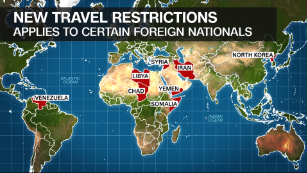The united states 'HOMEGROWN' Threat
The 'homegrown' threat
The terrorist threat in the United States is an overwhelmingly homegrown phenomenon. Eighty-five percent of the 418 militants charged with terrorism-related crimes in the United States since 9/11 are citizens or legal permanent residents, and just under half were born American citizens.
A US Department of Homeland Security report leaked earlier this year shows that the department itself came to the same conclusion when it considered which citizens of which countries posed a threat. The report stated that citizens of the original travel ban countries were "rarely implicated in U.S.-based terrorism," an assessment that's quite unlikely to be changed by the inclusion of Chad, North Korea and Venezuela.
The new travel ban portrays the selection of banned countries as the result of a review process around the world that identified these countries as having insufficient security measures or that are unwilling or unable to cooperate with the United States on security.
However, the Trump administration has given little reason to trust its review process or assessments when it comes to the travel ban and immigration policy.
The first travel ban in late January was rolled out in a rush that met with legal challenges and caused disruptions at airports.
Since that first rollout, key White House policy adviser Stephen Miller has cited misleading statistics on the number of terrorists from travel ban countries in which he included non-terrorism cases and individuals who had never set foot inside the United States before their extradition for trial on terrorism charges.
When the administration rolled out its second version of the travel ban, the Department of Homeland Security provided as justification the case of Mohamed Osman Mohamud, who was convicted of plotting to attack a Christmas tree lighting in Portland, Oregon, in 2010.
While Mohamud was born in Somalia, his case does not support the travel ban. He came to the United States as a young child more than a decade before he became radicalized here and carried out his plot -- and it was his father who provided the tip to police regarding his militant activity.
It is possible that the DHS review revealed real insufficiencies in the listed countries' security measures that required reforms. However, given the administration's rushed efforts to implement previous versions of the ban and its misleading defenses of the ban, it seems plausible that the administration crafted a process to add two non-Muslim majority countries to the ban so as to shore up its legal defense when the US Supreme Court takes up the question next month of the president's authority to issue such a ban.


Comments
Post a Comment